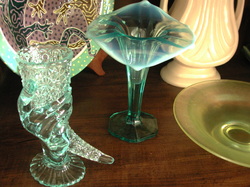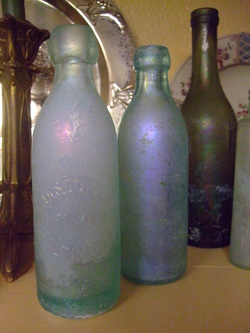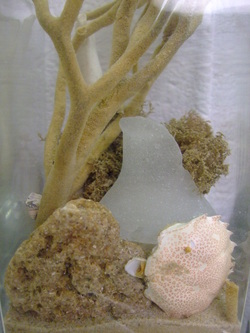


Are sweeter… Forever wilt thou love, and she be fair!”
Than ours, a friend to man, to whom thou say'st,
"Beauty is truth, truth beauty"---that is all…”
|
I tend to collect things, but I used to reassure myself that at least I would never collect glass. I learned to collect things from my father Dover, who in addition to his day job had a long career as a collector, dealer, art critic and general junker starting in the mid-1950s. I remember Dover clerking for my auctioneer uncle Hampton at country estate auctions in the Eisenhower era, while I manned (boyed?) a washtub full of ice with its burden of Tru-Ade and Nehi and RC Cola and other now extinct soft drinks and collected a nickel apiece from farmers and dealers who, in that time and place, personally remembered the Great War and still thought McKinley was just old news. As Dover used to say, the whole past is so recent, and history itself so short, you might wonder if there’s enough past left to get on with.  Even when Eisenhower was still president, glass was one of the more obvious and abject collecting manias. The great Carnival Glass renaissance, which defined the Kennedy era and remained a dominant social reality throughout LBJ’s first term, was about to go into full swing. Many West Virginia and Ohio glass manufactories were still emphatically in business and people were already passionate about old Fostoria, antique Bohemian glass, and Loetz, Kralik, Tiffany and art glass generally. Indeed glass was a field for sophisticated palates and some pretty severe idiocy. The craze for old rare bottles was also in full swing, and the excitement and open bidding for such things that I saw as a child seemed openly ridiculous to me. “Ha ha ha,” I said. “That will be a nickel.” A third of these nickels still had buffalos on them. Oh to have those nickels back now. And the washtub.  Glass, like some astronomers say about distant galaxies, has a gravitational force all its own. The dynamic tension between glass and the clay arts of porcelain, pottery and china is probably the source of the Dark Energy that arguably holds all other collecting together in modern quantum collecting theory. Much later in life, when the vortices of energy created by pairing glass with porcelain and metal had become quite fascinating to me, I found that I was collecting glass after all. I collected in denial, assuring myself that I was just owning a piece of glass here and there, not collecting it. And in moments of greater lucidity, I reassured myself that even if I did collect glass someday, at least I would never fall so low as to collect bottles. A degraded interest in old bottles, so consonant in taste with chewing tobacco and spitting on other peoples’ feet, would never be my lot. I had more character than that anyway. Maybe all probability waves collapse sooner or later. What is it about a bottle? In 1880 some Irishman in Baltimore poured red hot glass into a mold and tonged up the base of a blob top so some other Irishman could glop a rim on it and let the common object, all aqua-impure, cool off enough to pour soda water into it and cork it with a wire bail. A basket of these in straw, or let us be generous and say ice, was hoisted onto a Chesapeake packet boat and off it went to Hampton Roads for an excursion. The passenger, I imagine his name was Jerome, splurged on a nickel’s worth of fancy soda-waters (a shield nickel in that period) for himself and his inamorata, Elsie, who was very fond of iced soda water. No doubt he used the serrated back of his Bowie knife to prize the bails up on a couple of these. Suitably quenched by the plain yet bubbly fluid, product of the genius of Joseph Priestly, Jerome and Elsie flung their barely regarded empty aqua blob tops into the bay. The bottles sank like stones, since the soda bottles of that era weighed as much as some artillery shells.  A hundred years passed, and then decades more. A thousand crabs walked over, or sat upon, those bottles. These crabs would have had no idea what bottles were or had ever been used for, products of an alien civilization. Fish swam by, in equal or at least similar ignorance, pursued through the murky green estuary by the shadows of fishing boats, crabbing boats, oyster boats, ocean liners, tobacco scows and cattle barges. Spring rains, hurricanes, winter ice, seagulls and pelicans ruffled the glaucous surface of the great estuary. Moons and tides ebbed and flowed as great fleets coursed overhead: McKinley’s armada en route to wrest Cuba from the Spaniards, the troopships of the Great War, the Liberty Ships, the Atlantic Fleet, the nuclear powered vessels of the Cold War, the Vietnam War, the Iraq War, the other Iraq War, not to mention the Coast Guard, not to mention all the peaceful commerce of this world and the world to come. Despite all this, the mute testimony of a forgotten excursion still lay on the bottom, slowly turning iridescent, little regarded by the surrounding clams. “Heard melodies are sweet, but those unheard Are sweeter… Forever wilt thou love, and she be fair!” What is a bottle indeed… “Thou shalt remain, in midst of other woe
Than ours, a friend to man, to whom thou say'st, "Beauty is truth, truth beauty"---that is all…”
2 Comments
|
AuthorGary Dale Mawyer, a Central Virginia native, has over 40 years of publishing and editing experience and lives with his wife Karen and two cats in Albemarle County. Sites I likeafroculinaria.com/
largea.wordpress.com/livinglisteningandthingsilove naturalpresencearts.com/ someperfectfuture.com Archives
July 2024
|